Turban - headdress, which came to the modern fashion industry from Indian and Muslim culture. Initially considered an exclusively male element of clothing, it gradually began to be used by women to create a stylish image with a slight oriental touch.
You can sew a turban or chalma yourself, using detailed patterns and making a unique and stylish headdress for warm or cold seasons.
Sewing features
Designers recommend sewing a women's head turban or chalma from natural or mixed, dense fabrics that hold their shape well. A necessary condition for their selection is the softness of the material.
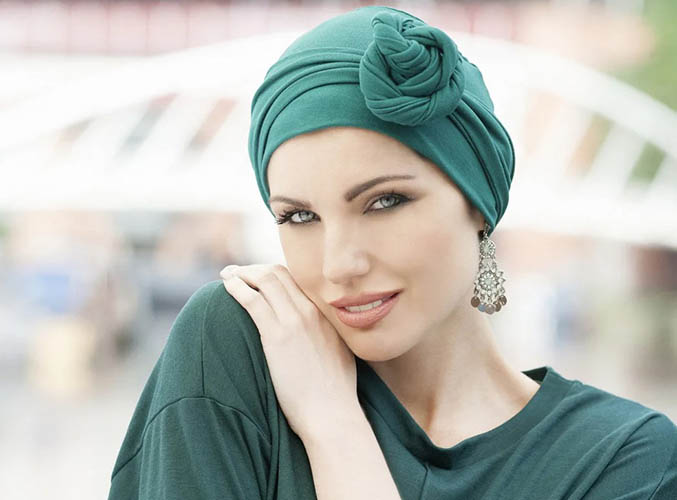
Women's headdress:
- Traditionally, in Muslim countries, silk or brocade are used to make turbans, but you can also find headdresses made of velvet and cashmere.
- For the cold autumn-winter period, semi-woolen fabrics or artificial short-haired fur are suitable.
- You can sew a turban from cotton, but it is not recommended to use linen fabric, felt and thin knitwear due to the characteristics of the material, since linen and felt are too hard and will create unsightly, hard bends when assembled. Thin knitwear, on the contrary, is a very soft fabric, but it stretches a lot, which is why the finished product can very quickly lose its original shape.
To sew a traditional Muslim turban, you will need from 4 to 20 m of fabric, which must be wrapped around the head in a special way. Under the turban, you need to wear a hat, scarf or skullcap, which will give the product stability and prevent it from slipping off the head.
Modern women's turbans have a slightly different texture and their shape is more reminiscent of a turban made of thick rectangular fabric, slightly gathered in the front. The model can be worn on its own, holds its shape well, does not require the use of an additional scarf or hat and, if desired, can be decorated with decorative elements.
Before purchasing the material and starting work, you need to decide on the type of turban and decide on the style, selected depending on the type of face.
The turban has the following types:
| Elongated face shape | With such a structure, experts recommend paying attention to low models, distinguished by horizontal seams and many folds. Abundant decor from beads, beads and even, if desired, feathers is also allowed. |
| Oval shaped face | You can choose a turban (chalma) of any cut and style. It is not recommended to wear only very high, multi-tiered products made from a large amount of fabric laid in layers. |
| Round face shape | With this type of face structure, experts advise girls to wear high hats that lift the forehead area, visually stretching the oval of the face. |
| Triangular shaped face | It is recommended to wear a massive turban with all sorts of decorative elements, made of silk, brocade, velvet, which will emphasize the oval of the face and add a light, oriental flavor to the chosen image. |
| Rectangular face shape | To correct massive cheekbones, experts recommend choosing a turban with light folds and drapery, without an abundance of decorations. |
You will also need the following for sewing:
- a pattern diagram constructed in accordance with the desired dimensions;
- threads, pins and a needle;
- tailor's scissors;
- sewing machine;
- tailor's soldering iron or overlock.
Taking measurements
Work on the product begins with taking measurements, for which you need:
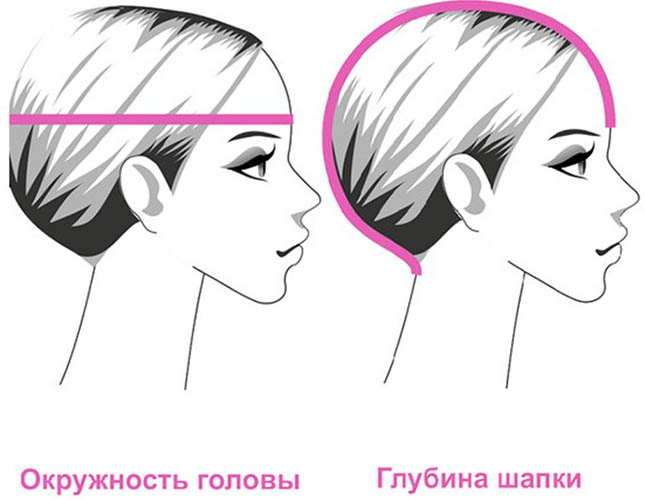
- Determine the depth of the headdress, placing the measuring tape on your forehead and stretching it to a point on your neck. You can also measure the distance from ear to ear, through the crown, divide by 2 and add 1-3 cm to the resulting value.
- Calculate head circumference, for which you need to wrap the tape measure around your head slightly above your eyebrows and touching the most protruding part of the back of your head.
Schemes with description of works
A turban for a woman's head can be sewn in several ways. It can also be made without a pattern from a regular chiffon scarf or stole, forming folds from several layers of the product wrapped around the head. In this case, you do not need to fix it with threads, it is enough to use a brooch, tie the ends of the scarf into a bow or lower them down onto the shoulders at the back.
Several patterns are also used to sew the model, varying depending on the appearance and purpose of the product.
A simple turban-turban in the shape of a hat
A women's turban in the shape of a hat can be made using 2 seams from a rectangular piece of woolen fabric, one and a half times the circumference of the head.
You can also replace it with a regular knitted scarf. You will also need:
- threads that match the fabric tone and a needle;
- a brooch for decorating a product.
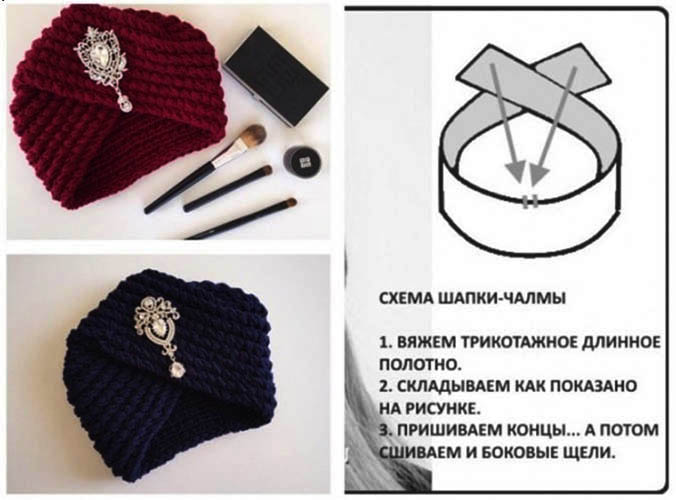
During work you need to:
- Fold the selected material (or knitted scarf) in half to form a circle corresponding in size to the head circumference.
- Throw the free ends of the resulting cross of fabric back and sew to the back of the product.
- Try on the resulting turban and attach the brooch that decorates it to the front.
With a brooch
Women's head turban with an original angle at the front, complemented by any volumetric brooch you like can be sewn from thick elastic knitwear or cashmere, size 30-35 cm. You will also need:
- threads, pins and a needle;
- sewing machine;
- overlock;
- graph paper, scissors and tailor's chalk;
- brooch for decoration.

In the process of working on the product you need to:
- On graph paper, draw a rectangular pattern with dimensions of 30/60 cm, cut it out, place it on the prepared material from the back side, trace along the contour with tailor's chalk (soap or pencil) and cut along the contour with an allowance of 1.5-2 cm.
- Fold the resulting piece of fabric in half, round off the 2 upper corners and overlock the edges.
- Sew the side and top edges of the workpiece, leaving the bottom edge free. There is no need to cut the thread used for sewing.
- Turn the headdress right side out and pull it over the mannequin (you can replace it with a regular three-liter jar).
- To form the front gathering, step back 3-4 cm from the edge of the product, make folds in the material (carefully placing it on top of each other in the shape of a "herringbone") or stitch it with a needle and tighten the thread, forming a gathering. You can also carefully pull the material from the back of the product and make a fold from it on the front.
- Carefully stitch the resulting folds, and cut off the remaining fabric, first leaving a 2 cm section from the edge for processing the bottom. Now it will need to be folded over from the wrong side and sewn.
- Turn the turban inside out and, carefully pulling the thread left earlier on the side cuts, gather the occipital part into folds and stitch it.
- Correct all seams and finish the edges with an overlock.
- Try on the resulting product and attach a brooch to the top of its central, front fold.
From bulk material
A women's head turban made of voluminous fabric measuring 120/110 cm is sewn in the same way as the previous sample.

Tools used in the work:
- thread and needle;
- any decor.
During work you should:
- Construct and then cut out a pattern from paper, place it on the wrong side of the fabric, outline with tailor's chalk (pencil or soap), first adding 25 cm to the bottom seam.
- Cut out the fabric with a mandatory seam allowance of 1.5-2 cm and sew the front and back parts of the product along the side seam, and then use a sewing thread to gather the top and side edges a little.
- Process the lower edge on an overlock, then turn the product right side out and put it on a mannequin (you can replace it with a three-liter jar of water).
- Form folds (gathering) on the front and back of the turban, grabbing and placing the fabric on top of each other in a herringbone pattern. The finished folds should be secured with stitches. The excess fabric should be cut off, and its edge should be folded inside the product and sewn on the reverse side.
- Turn the turban inside out, form folds in the back of the head and secure them with stitches.
- Try on the resulting product and decorate it to your taste.

The second option for making a turban from a voluminous piece of fabric involves the use of chiffon, satin, velvet cloth, one and a half times the size of the head, as well as:
- threads of a suitable shade and a needle;
- decoration in the form of a brooch.
When working you need to:
- Fold the prepared material in half to form a circle with a diameter corresponding to the circumference of the head.
- The intersection of the ends of the material will serve as the front, and the free ends of the fabric should be thrown inside the structure and sewn by hand.
- Attach a brooch to the middle of the turban.
From a towel
A women's turban for the head can be made from any voluminous terry towel. It will be fastened with a button, which will make the structure for drying hair more stable and prevent it from falling off the head.
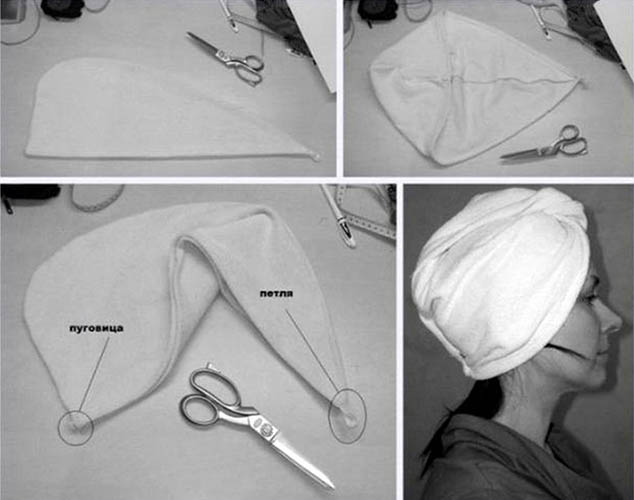
You will also need:
- threads to match the fabric and a needle;
- scissors;
- any button;
- lace 9 cm;
- tailor's soldering iron;
- sewing machine.
During work you need to:
- Using manicure scissors, rip the seams on the towel, removing the hem lines and cut the material along the bias.
- Place the front and back pieces on top of each other, cut off the top corner to create a semicircle, and stitch the side and back seams.
- The bottom edge should remain straight, it needs to be cut and processed with an overlock or a tailor's soldering iron, preventing possible fraying of the fabric.
- Prepare a 9 cm long cord, singe its edges with a soldering iron, form a loop out of it and sew it to the top edge of the structure.
- Sew a button to the bottom of the product.
With assembly
A turban in the form of a cap can be made of corduroy or thick knitwear 100/70 cm long (with a head circumference of 52 cm). It is recommended to fold thinner fabric in half.
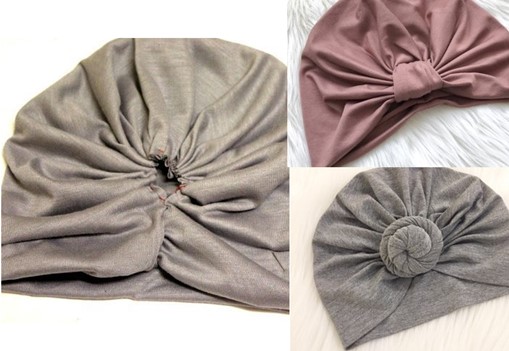
You will also need:
- graph paper and pencil for drawing the pattern;
- a needle and thread in the same color;
- scissors;
- sewing machine.
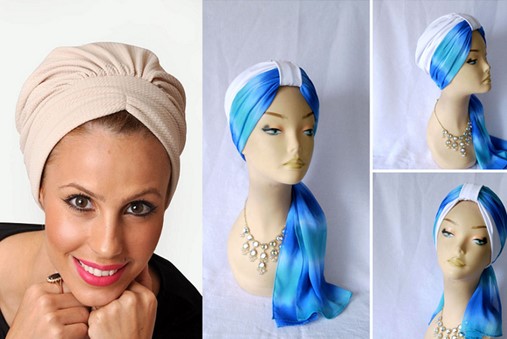
During work it is required:
- Construct a pattern according to your measurements, apply it to the material, trace with chalk (pencil or soap) and cut out the product, leaving a mandatory seam allowance of 1.5 cm.
- Fold the material in half along the width and use scissors to round off its top part, moving strictly from the corner to the middle.
- Cut it out and then machine stitch along the cut edge. Leave the thread and use it to tighten the product so that a hole with a diameter of 2 cm is formed in the center. Sew the resulting folds as close to the edge as possible by hand (stitch "needle inside") or on a sewing machine.
- Make a rectangular “bridge” from the fabric, round off its edges and fold the material in half so that the front side is inside, and secure it with a machine stitch without stitching the middle, through which the product can be turned inside out.
- Place the resulting "jumper" in the center of the headdress and turn the seam inside out. Hand stitch the product along the cut edge, securing the detail, and then turn the turban right side out and tie the ends of the ribbon, creating a beautiful decor.
- If desired, you can attach ribbons, a brooch, or decorate the resulting model with beads.
- You can add a headband to the finished product, for which you should cut a bandage from the material equal to the circumference of the head and sew it along the bottom edge to the assembled base.
- To decorate such a product, you can also use a contrasting shade of chiffon scarf, threading it through the bridge and letting the edges hang down at the back of the head.
With a bow
A women's turban, decorated with a satin bow in an oriental style, can be sewn from thick silk, measuring 100/150 cm.
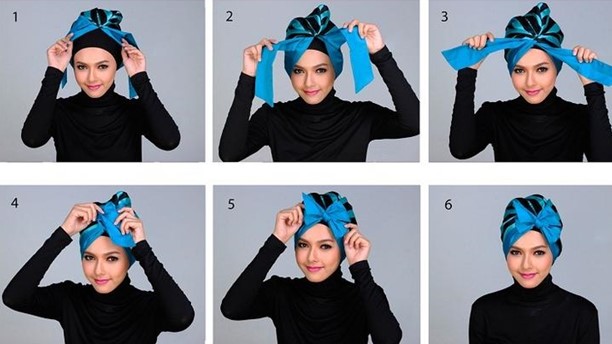
When drawing up a pattern, attention must be paid to the following values:
- OG (head volume).
- W (product width). It is recommended to add 20-30 cm to it to create drapery and folds.
- DI (product length). Its value should be at least 70 cm (taking into account the future bow).
When creating a model you need to:
- Cut out the finished pattern, place it on the material from the wrong side, trace around the contour with tailor's chalk (pencil or piece of soap) with a mandatory seam allowance of 1.5-2 cm.
- Process the edges of the cut out elements with an overlock or a sewing iron, which will prevent the fabric from fraying.
- Machine stitch around the rounded perimeter, leaving a 2 cm opening at a height of 9-10 cm.
- Iron the finished seams, sew a zigzag stitch to secure them and hem the bottom of the garment, turning the fabric along the edge from the wrong side by 1 cm.
- To create a jumper, cut a rectangle 4/5 cm wide from the main material, fold it, machine stitch from the wrong side, turn it inside out and sew the ends.
- Thread it through the hole left in the turban, wrap it around your head, leaving the tails, then bring them to the front and tie them into a bow.
- On the finished headdress, you need to smooth out the sides of the bow and try on the turban.
For a girl
A turban for a girl of 5-6 years old can be made in the form of a small hat covering the hair, decorated with a decorative headband with rhinestones or a bow.
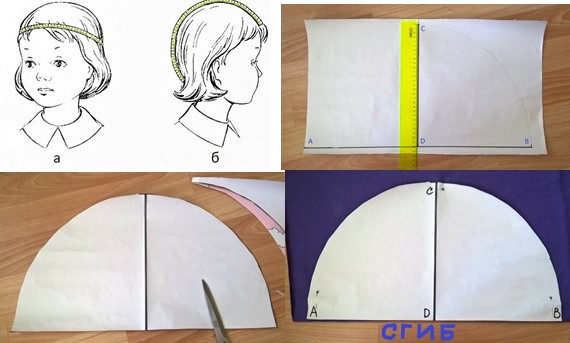

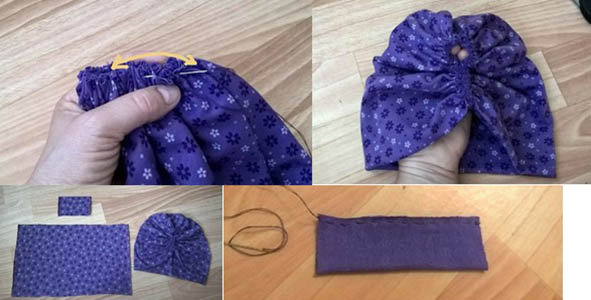
To create it you will need to take:
- a piece of thick knitted fabric measuring 100/105 cm;
- scissors, thread of a suitable shade with a needle;
- graph paper for the pattern and a pencil.
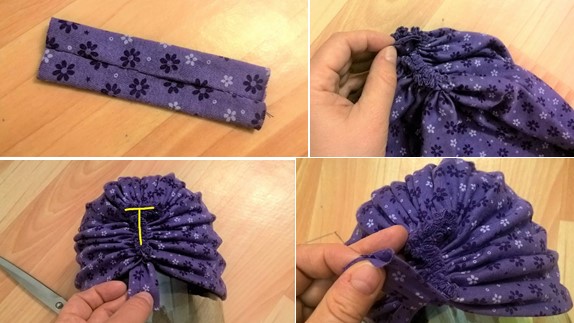
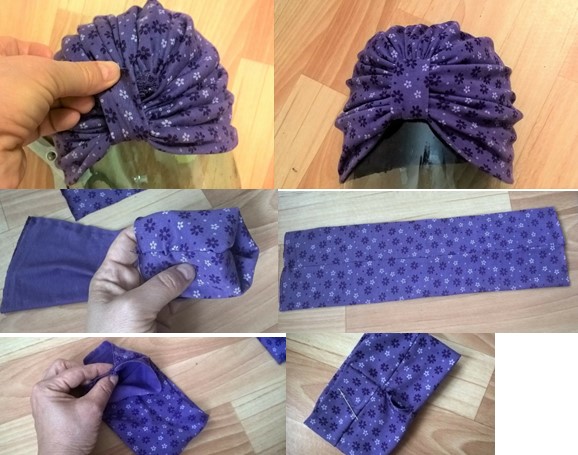
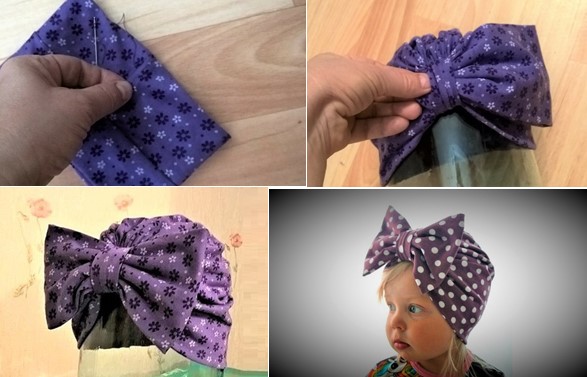
During work you need to:
- Taking into account the value of OG (head circumference) and the length of the product from the back of the head to the forehead (LOF), construct a pattern where the values AB will be equal to OG, and CD – LOF - 2-3 cm. Connect the points ACV with a semicircle.
- Cut out 2 identical patterns, place them on the material, trace with tailor's chalk (or pencil) and cut out, adding 2 cm for seams.
- Place the finished pieces together so that the front side is inside and sew by hand or machine stitch in a semicircle, and then, without cutting the thread, pull the material together with it, forming folds.
- Sew the resulting assembly from the wrong side by hand (using a backstitch), leaving a 2 cm diameter hole at the corner at the top of the assembly.
- From the remaining material, cut out 2 rectangles: 15/8 cm for the bridge and 50/30 cm for the bow.
- Fold the rectangle for the “jumper” in half widthwise (with the right side facing inward), sew (to the edge) and turn inside out.
- Insert it into the hole of the turban, wrap it towards the bottom in a T shape and sew it on, hiding the gathering seam.
- To create a bow, fold the fabric piece in half, machine stitch along the edge (or sew by hand), turn it right side out, fold it in half again and sew the ends in a circle, gradually turning the product and leaving 4 cm from the edge unsewn. Turn the unsewn part over and hide it by hand with a “blind stitch”.
- Place the new piece into the headdress bridge and straighten the bow.
Adviсe
When making a turban, experts advise girls and women to focus on the leading fashion trends, which offer:
- Create a product in a traditional oriental style, choosing for sewing thick silk, brocade or velvet, plain or decorated with oriental patterns, and complementing it with numerous decor.
- Choose a bohemian style, combining elements of fabric and fur in a simple cut product.
The most popular hats in the 2023 fashion season will be those made in the following shades:
- wine;
- gray;
- powdery pink;
- milky white;
- turquoise;
- emerald green.
Stylists suggest wearing a turban (chalma):
- With trouser suits in grey, brown or beige, complementing the urban style look with a clutch bag and lipstick to match the turban.
- With an evening dress or a one-piece swimsuit – combine a silk or brocade headdress with voluminous jewelry.
- With a fur coat made of natural or artificial fur - complementing the look with a turban made of short fur, decorated with a massive eyebrow.
A women's turban is a stylish headdress whose cut replicates the traditional male element of Hindu or Muslim costume.
Made from thick material, it is easy to cut and sew, does not require a complex pattern and is decorated with a brooch, bow or any decorative elements, allowing you to create a stylish urban look with a slight touch of oriental flavor.
Video about making a turban
